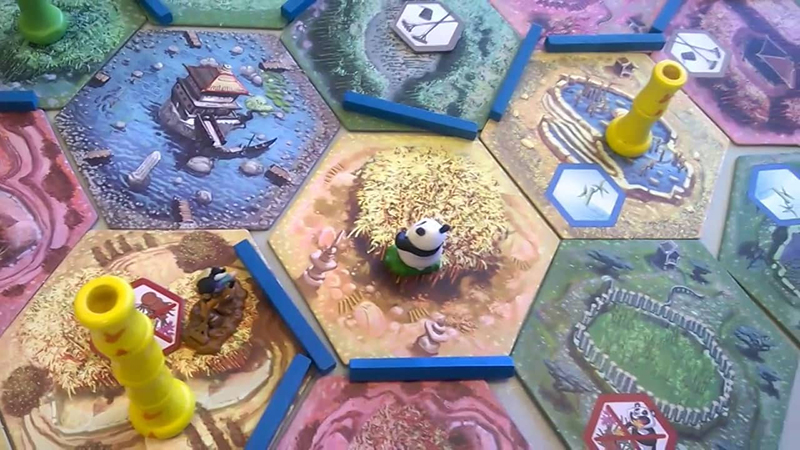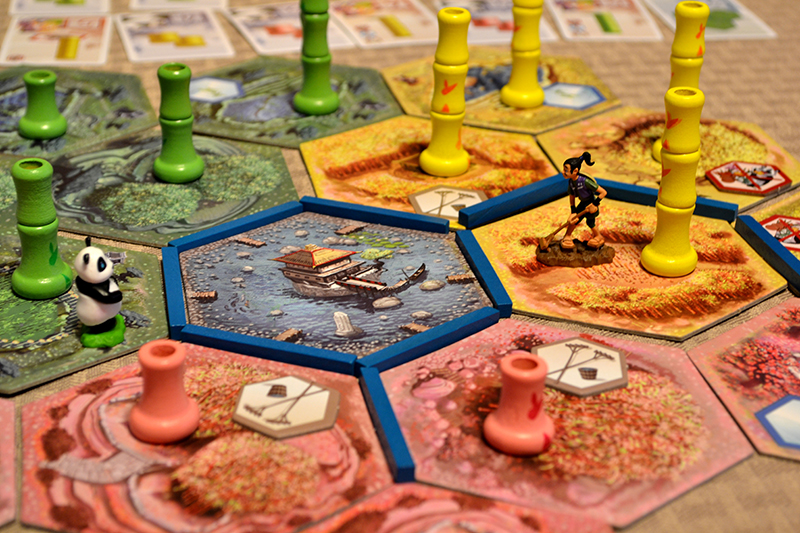Way, way back in Feudal Japan, the Emperor of China gifted a giant panda bear to the Japanese Emperor as a symbol of peace. Since then, the Japanese Emperor has trusted his court members with the difficult task of caring for the panda by tending to his bamboo garden.
As the Emperor of Japan wants to have a beautiful garden, players will need to cultivate plots of land and grow bamboo with the help of the Imperial Gardener. On top of this, our politically important panda bear needs to be well-fed, so much of this tasty bamboo is going to be sacrificed to the ravenous appetite of the panda. It’s up to you to balance your objectives as the panda runs amok through your Imperial garden.

There are three different types of objectives that will score points: laying out the communal garden tiles in certain patterns, growing specific types of bamboo, and getting the panda to eat different kinds of bamboo. Each objective (which is hidden from the other players) is worth a number of points, and once one player has achieved a certain number of objectives, the final round is triggered.
You work towards these objectives by taking two out of six possible actions on your turn. You can choose to build plots of land by placing garden tiles, move the gardener to grow bamboo on the land, move the panda so it can eat bamboo that’s already been grown, place river pieces to irrigate garden tiles so that they can grow bamboo, and you can pick up new objective cards if you’re struggling with (or have finished) the ones you have.
To add some extra flair, at the beginning of your turn you will roll the weather die, which decides the weather for the day. This different weather grants you a specific bonus on your turn, so it could mean gaining a third action, making it rain and irrigate on a tile of your choosing, or getting to move the panda to wherever you want.

As each player pushes to achieve their own objectives, the game board changes constantly. Everything the other players are doing is to meet their own objectives, and therein lies the challenge: how your plans either survive or take advantage of other players’ moves. It’s possible, and quite likely, that you have everything set up perfectly only to have another player move a piece out of place at the last second, spoiling your chances of completing an objective. At the same time, it’s also just as likely that other players will arrange things perfectly for you to meet one or more objectives during your turn. You might even find yourself at odds with your own objectives!
This creates a great sense of tug-of-war as players try to further their own points and inadvertently mess with others. This also means one strategy can’t dominate the game, which makes the gameplay fairly balanced. After a couple of rounds, Takenoko’s gameplay becomes fairly instinctual, and you’ll quickly find that you don’t need to refer to the rulebook.

Even though Takenoko’s art style looks fairly cartoonish, it’s a gorgeously designed game, and incredibly well thought out. The plot tiles and bamboo pieces bring the garden to life as you play, and the panda piece is damn close to the most adorable miniature I’ve ever seen. Beautiful components aside, every aspect of the game’s design is incredibly intuitive, and very easy to pick up and play.
The gameplay ties very nicely into the theme, and you never feel like a mechanic has been shoehorned in for the sake of it, or that the theme is tacked on. They are perfectly linked, and every step you take in the game feels logical. This great marriage of gameplay and theme also reduces the learning curve, as everything just makes a lot of sense.
There are some luck based elements which can put a small damper on the game, such as drawing a difficult objective or getting a bad roll on the weather die, but it’s pretty easy to bounce back. Of course, another player eating the bamboo you had your eye on can be irritating, but Takenoko is well balanced between luck and strategy, and gives you ample time to recover from any negative twists.

Takenoko has enough complexity to make you feel accomplished, but not so complex as to overwhelm new players. And, where it may lack in the heavy strategy department, it makes up for in spades with its elegant design and entertaining gameplay.
Vital statistics:
- Players: 2-4
- Ages: 8+
- Estimated play time: 45 minutes
- Complexity: Low
- Mechanics: Dice Rolling, Grid Movement, Modular Board, Pattern Building, Set Collection, Tile Placement
- Published: 2011
Last Updated: January 10, 2017
| Takenoko | |
|
Easy to learn and relatively quick to play, Takenoko is a great game to use when introducing friends to a new generation of tabletop games.
|
|
|---|---|























Hargrim
January 10, 2017 at 13:58
Great review! Got my sister this for her birthday last year. The panda mini was a hit, don’t think she put it back in the box once that day, everyone had to see it
Craig "Crios" Boonzaier
January 10, 2017 at 14:47
This is such a fun game, always make sure we do a round on international tabletop day.
GooseZA
January 11, 2017 at 14:40
Fantastic game. And that panda is just adorable.